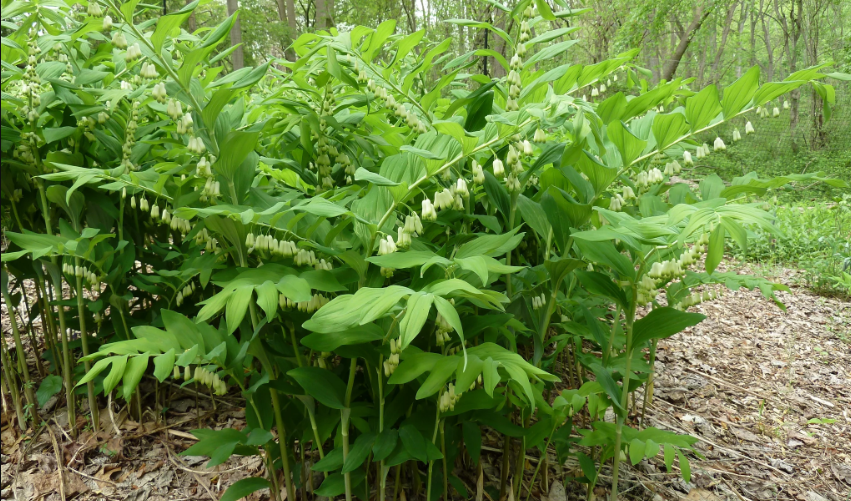
Solomon’s seal is a genus of flowering plants, also known as King Solomon’s-seal or Polygonatum, belonging to the family Asparagaceae, subfamily Nolinoideae. There are about 60 species in this group, but only a few are commonly grown as ornamentals. They are herbaceous perennials with attractive architectural form.
Solomon’s seal is a popular garden plant because of its graceful arching stems, small white spring blooms and bluish-black berries. The genus name Polygonatum comes from Greek words poly meaning many and gonu meaning knee joint, in reference to the jointed plant rhizomes.
Solomon’s seal bloom with clusters of two or more small, bell-shaped flowers that dangle beneath the stems. The greenish-cream to white flowers arise at each node where the stems arch over and are therefore often hidden by the foliage. The flowers last for several weeks in the spring, then are followed by spherical, blue-black fruits resembling small grapes that are often eaten by birds.
The plants grow and spread at a modest pace to form colonies of plants and can take a few years to reach blooming maturity when started from seed. Solomon’s seal pairs well with other shade-loving plants like hostas, ferns, and coralbells.
There are several species of Solomon’s seal commonly grown as ornamentals in the US, including both native and exotic species. Most species have solid green leaves but some have variegated leaves. The leaves turn lemon yellow to brown in autumn and the stems wither away for the winter. Some of the most common ones are:
- Polygonatum biflorum: Known as small Solomon’s seal, it is a Missouri native wildflower that occurs in rich woods throughout the state. It grows in a mound to 1-3′ tall on unbranched stems. The small, bell-shaped, greenish-yellow flowers (usually in pairs) dangle in spring from the leaf axils along and underneath the arching stems. The leaves turn an attractive yellow in fall.
- Polygonatum x hybridum: This Solomon’s seal has gently arching stems with dangling pairs or clusters of cream flowers in late spring. The stout rhizomes are drought-tolerant and colonize well. It may reach 5 feet tall.
- Polygonatum odoratum ‘Variegatum’: A classic beauty for the shady woodland garden or part-shade to full-shade border. It grows up to 2-3 ft. tall and spreads 9-12 in. Slowly spreads by rhizomes to form colonies in satisfactory growing conditions.
- Polygonatum biflorum var. commutatum: Also known as Giant Solomon’s seal, it is native to most of North America east of the Rocky Mountains. The main feature distinguishing it from the more common Polygonatum biflorum is that the underside of the leaves have tiny white hairs.
Solomon’s seal is hardy in Zones 3-9 and can be propagated by division or from seeds, although seeds can take several years to achieve flowering maturity. The plant’s leaves turn lemon yellow to brown in autumn and the stems wither away for the winter.
The thick, fleshy, white, irregularly-shaped rhizomes bear rounded scars where previous year’s stems arose – and supposedly it is the resemblance of these scars to the two inverted triangles that were the symbol or seal of King Solomon that gave rise to the common name.
Solomon’s seal is not only a beautiful ornamental plant but also has practical uses. The edible parts include its leaf buds and young leaves, flowers, immature seed pods, seeds, and roots. The plant has also been used externally to reduce swelling and pain from bruises and insect stings.
Solomon’s-seals prefer rich, moist, well-drained soils in partial to full shade (where they will receive morning or dappled sunlight rather than afternoon sun) but they are quite adaptable to many situations, including those difficult dry shade spots near tree roots.
It is best to allow fallen leaves from trees to remain where Solomon’s-seal grows as a natural mulch and to form humus. They are very drought tolerant once established, have few insect or disease problems, and are not favored by deer. These plants can be grown from seed but they are easiest to propagate by division.
How to Grow and Care For Solomon’s Seals
- Soil Preparation: The plant thrives in moist, rich, well-drained soil. It prefers slightly acidic to neutral soil pH (5.0 to 7.0). To increase the richness of your soil, you can add a layer of compost around your Solomon’s seal each year. Allowing leaf litter to decompose around the plants creates a rich, humusy environment they enjoy.
- Sunlight and Location: Solomon’s seal plants are native to woodland areas, so they prefer to grow in a spot with some shade and dampness. A slightly acidic to neutral soil pH (5.0 to 7.0) is ideal. In the fall, frost will cause the plants to die back to the roots for the winter.
- Planting: You can plant Solomon’s seal in early spring or fall. Dig a hole twice the size of the plant’s root ball and place the plant in the hole, making sure the crown is level with the soil surface. Space the plants about 18 inches apart.
- Watering: Keep the soil moist but not soggy. Solomon’s seal can tolerate drought conditions once established, but it prefers moist soil.
- Fertilizing: Solomon’s seal doesn’t require a lot of fertilizer. A layer of compost around the plants each year is usually enough.
- Pruning: In late fall, the foliage will die back. You can cut the stems back to the ground at this time.
- Propagation: Solomon’s seal can be propagated by division in the spring or fall. Carefully dig up the plant and divide the rhizomes into sections. Each section should have at least one bud. Replant the rhizomes horizontally at 4-6 inches deep.
- Pests and Diseases: Solomon’s seal is generally resistant to pests and diseases. However, deer may eat the foliage in some areas.
- Winter Care: In colder climates, you may need to provide some winter protection for Solomon’s seal. A layer of mulch can help to protect the roots from freezing.